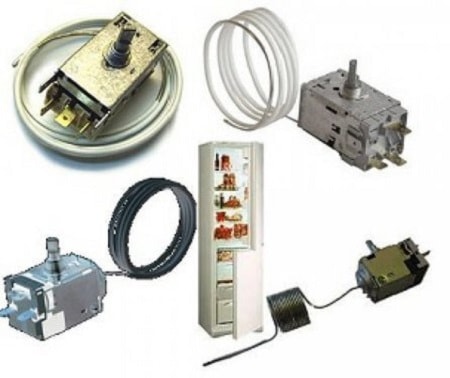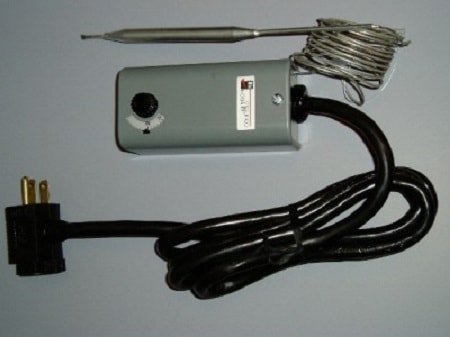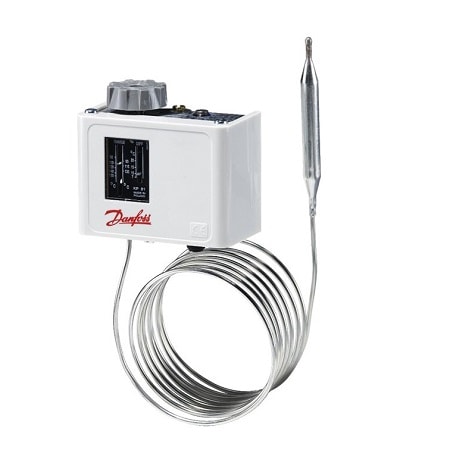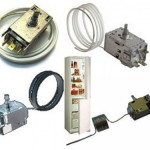Any model of a modern refrigerator has two thermal relays, differing in principle of operation and functionality. The first refrigerator relay is responsible for overheating of the compressor, and the thermostat for the refrigerator monitors the temperature range of the evaporator itself. Temperature controllers are mechanical and electrical.
Over the years, despite technical progress and new advances, the use of a thermostat for a refrigerator has remained unchanged. Simplicity and reliability are the main reasons for using a temperature controller for a modern refrigerator.
Thermostat functions
The thermostat inside the refrigerator is a kind of bell, with the signal of which the entire complex technological process is launched into operation. If the bell does not sound, the mechanism does not work, the production of cold does not start!
See also:
- 7 best Bosch refrigerators according to customer reviews
- 8 Best Samsung Refrigerators According to Buyers
- 9 Best Inexpensive Refrigerators According to Buyers
- 10 best LG refrigerators according to customer reviews
How the thermostat works
It is reliably known that the average life of a quality bellows is 5 years. Therefore, it makes no sense to talk about the ten-year operation of the equipment. As you know, the operation of a refrigerator consists of 4 phase states of freon, namely:
- Compression
- Condensation.
- Extensions.
- Evaporation.
In order to understand how freon helps to obtain a low temperature, we consider the process of its conversion in more detail.
Inside the evaporator, the circuit for lowering the temperatures, freon passes into a gaseous state, which it easily changes in the capillary tube of the thermal relay. As soon as the thermal reading changes, the temperature becomes lower than the threshold, the freon under pressure changes to liquid. This change in state contributes to a sharp decrease in pressure, and, consequently, to straighten the bellows.

At this stage, the contacts are closed, the control voltage is canceled from the engine thermal relay. The refrigerator stops producing cold exactly until the temperature switch is activated.
At this stage, freon is converted into steam, the pressure on the bellows increases sharply, which leads to the closure of the contacts to start the engine of household appliances.
Important:
Despite the duration of the freon tube, the change in the state of aggregation of the substance occurs exclusively at the end adjacent to the evaporator. Thus, the quality of operation of the refrigerator temperature switch is affected by the density of contact.And it is provided through sealant, special glue.
If the temperature relay fails, then replacing it for the master is not difficult. For this, it is recommended to replace the element with the same model and type. Otherwise, the thermal state of the refrigeration equipment will be strikingly different, and the result of the equipment operation will not be very pleasing.
Experienced craftsmen know that the thermal state of the relay can be adjusted. Thus, with dignity, they get out of the situation by tuning the operation of the cooler regulator to the user.
The control knob, which is turned to regulate the temperature, has a direct effect on the thermostat spring and, accordingly, on the thermal state of the unit.
However, this method of operation of the device cannot be used for electronic devices.
![]() See also - How to fill the refrigerator with freon at home
See also - How to fill the refrigerator with freon at home
Where is the thermal relay
The owners of refrigeration equipment with a mechanical thermostat are familiar with it in absentia. In most cases, during the installation, moving, rearranging furniture to facilitate the process, the owners took their hands on the temperature switch, without even knowing it. We touched the knob of the temperature controller to switch the temperature mode or the rotary mechanism of the relay itself.
Today it consists of two main elements, the appearance of which suggests the purpose and functionality:
- Box, consisting of control, actuators.
- An oblong, thin capillary.
So, let's figure out the intricacies of the temperature regulator in order.
The box consists of a hermetically sealed bellows, which is a cylindrical metal accordion that responds to temperature changes in the environment, pressure changes through its own linear dimensions.
For a general presentation, it can be noted that the appearance of the accordion is similar to a metal corrugated pipe (often used in household appliances). However, its complete isolation from the outside world testifies to hermeticity and accurate determination of indicators.
When the ambient pressure rises, the accordion contracts, and when the ambient pressure decreases, it stretches accordingly. The design also includes a spring that changes the response of the bellows according to the actual pressure.

The production of bellows, regardless of size and further use, is the same. For manufacturing, only high quality steel is used, which is drawn into a cylindrical shape. However, the most interesting part manufacturing process occurs next.
The resulting metal cylinder is installed inside a special machine, in which, under the press, the metal sheet is squeezed and straightened under a precisely defined force. Thus, an accordion is formed, which individually does not possess elastic properties, for example, like a spring. The finished accordion is easy to deform: stretch, compress, deform.
To balance the external pressure on the bellows, the possibility of use in measuring equipment, gas is pumped into it. Thus, any effect on the bellows can lengthen or stretch, change its shape.
However, it is obvious that a temperature switch with a sensing element will operate at any temperature. This does not guarantee convenience. It is much more pleasant when a device with an installed regulator changes the response threshold depending on the temperature inside the refrigerator chamber.
To achieve this, a spring is wound over the bellows. She spirals around him, locking the ends in the same place as the bellows. Therefore, the spring tension affects the threshold for starting the sensor.
Today there are models with one or more springs, the use of which depends on where it is used: in freezers, directly for the refrigerator.
Electronic temperature switches for refrigerators
Thermal relays of electronic type make it possible to more flexibly regulate the operation of the entire system. The sensitive element in this case is a special resistor or thyristor. The main disadvantage of using electronic relays in refrigerators with high energy consumption is the service life.
Electronic temperature relays are especially popular for refrigerators with linear compressors, in which the thermal reading is achieved along with low energy consumption, noise level, dimensions.

That is why, today, for the production of refrigeration equipment, linear compressors are used that work continuously and precisely maintain the set temperature.
As you can see, mechanical and electronic thermal relays differ in sensitivity, service life, and reliability. Therefore, choosing household appliances for purchase, it is worth paying special attention to the type of temperature switch.
See also:

